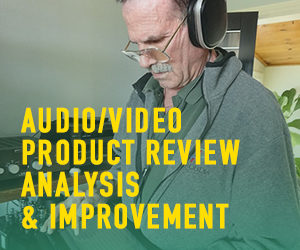Introduction
As some of you know, photography is one of my two hobby passions (the other being high-end audio). I have been into photography since I was about 5 years old, when my mother gave me a Brownie Kodak camera.
I have owned many different cameras over the years, including Canon, Leica, Minolta, Nikon, Olympus, Pentax, Sony, and others. I had been developing my own black & white film and prints, using a home dark room for the film and the local community college for printing with an enlarger.
Once digital cameras were here, I slowly made the transition from analog to digital and now, since film, paper, and chemicals are hard to come by, I am a totally digital photographer.
In the past few years, I believe that digital photography has surpassed film in resolution if not color (Kodachrome is tough to beat). Color will be the next plateau of quality to reach.
The camera under review here is the Sigma SD Quattro H mirrorless. This style of camera is known as a CSC, or Compact Systems Camera. It has a very unusual digital sensor, discussed below. The lens that arrived with the camera is a Sigma 24-35 mm f/2 DG HSM Art Lens with a Sigma SA mount.
Specifications
Camera
| Format | Interchangeable Lens Mirrorless Digital Camera | ||||||||||||||||||||||||||||||||||||||||||||||||||||||||||||||||||||
| Compatible Lenses | Sigma SA mount | ||||||||||||||||||||||||||||||||||||||||||||||||||||||||||||||||||||
| Lens Mount | SIGMA SA bayonet mount | ||||||||||||||||||||||||||||||||||||||||||||||||||||||||||||||||||||
| Angle of View | Equivalent to approx. 1.3 times the focal length of the lens (on 35mm cameras) | ||||||||||||||||||||||||||||||||||||||||||||||||||||||||||||||||||||
| Image Sensor | Foveon X3 direct image sensor (CMOS) | ||||||||||||||||||||||||||||||||||||||||||||||||||||||||||||||||||||
| Image Sensor Size | 26.7 mm × 17.9 mm (1.0” × 0.7”) (UPS-H) | ||||||||||||||||||||||||||||||||||||||||||||||||||||||||||||||||||||
| Number of Pixels | Effective Pixels: Approx. 38.6 MP (Top): 6,200×4,152 (Middle): 3,100×2,076 (Bottom): 3,100×2,076; Total Pixels: Approx. 44.7 MP | ||||||||||||||||||||||||||||||||||||||||||||||||||||||||||||||||||||
| Aspect Ratio | 3:2 | ||||||||||||||||||||||||||||||||||||||||||||||||||||||||||||||||||||
| Storage Media | SD Card, SDHC Card, SDXC Card, Eye-Fi Card, 11 Types | ||||||||||||||||||||||||||||||||||||||||||||||||||||||||||||||||||||
| Color Mode | (Standard, Vivid, Neutral, Portrait, Landscape, Monochrome, Cinema*, Sunset Red*, Forest Green*,FOV Classic Blue*, FOV Classic Yellow* )**It is not possible to select the mode when it is set as DNG. | ||||||||||||||||||||||||||||||||||||||||||||||||||||||||||||||||||||
| File Size | RAW – X3F
RAW – DNG [3:2]
|
||||||||||||||||||||||||||||||||||||||||||||||||||||||||||||||||||||
| Settings | 12 types (Auto, Auto (Lighting Source Priority), Daylight, Shade, Overcast, Incandescent, Fluorescent, Color Temperature, Flash, Custom 1, Custom 2, Custom 3) | ||||||||||||||||||||||||||||||||||||||||||||||||||||||||||||||||||||
| Type | Electronic viewfinder (approx. 2,360,000 dots color LCD monitor) | ||||||||||||||||||||||||||||||||||||||||||||||||||||||||||||||||||||
| Viewfinder Frame Coverage | Approx. 100% | ||||||||||||||||||||||||||||||||||||||||||||||||||||||||||||||||||||
| Viewfinder Magnification | 0.96x (-1m-1, 50mm F1.4 at infinity) | ||||||||||||||||||||||||||||||||||||||||||||||||||||||||||||||||||||
| Eye point | Approx. 21mm (–1m-1) | ||||||||||||||||||||||||||||||||||||||||||||||||||||||||||||||||||||
| Diopter Adjustment Range | Approx. -4m-1 to +2m-1 | ||||||||||||||||||||||||||||||||||||||||||||||||||||||||||||||||||||
| Auto Focus Type | Phase difference detection system + Contrast detection system | ||||||||||||||||||||||||||||||||||||||||||||||||||||||||||||||||||||
| AF Point | 9 points select mode, Free move mode (It is possible to change the size of Focus Frame to Spot, Regular and Large), Face Detection AF Mode | ||||||||||||||||||||||||||||||||||||||||||||||||||||||||||||||||||||
| AF Operating Range | EV -1~EV 18 (ISO 100, f/1.4) | ||||||||||||||||||||||||||||||||||||||||||||||||||||||||||||||||||||
| Focus Mode | Single AF, Continuous AF (with AF motion prediction function), Manual | ||||||||||||||||||||||||||||||||||||||||||||||||||||||||||||||||||||
| Focus Lock | AEL/AF lock button is pressed, or shutter release button is pressed halfway | ||||||||||||||||||||||||||||||||||||||||||||||||||||||||||||||||||||
| Metering Systems | Evaluative Metering, Spot Metering, Center-Weighted Average Metering | ||||||||||||||||||||||||||||||||||||||||||||||||||||||||||||||||||||
| Metering Range | EV 0~EV 17 (50 mm f/1.4, ISO 100) | ||||||||||||||||||||||||||||||||||||||||||||||||||||||||||||||||||||
| Exposure Control System | (P) Program AE (Program Shift is possible), (S) Shutter Speed Priority AE, (A) Aperture Priority AE, (M) Manual | ||||||||||||||||||||||||||||||||||||||||||||||||||||||||||||||||||||
| ISO Sensitivity | ISO 100-6400 | ||||||||||||||||||||||||||||||||||||||||||||||||||||||||||||||||||||
| Exposure Compensation | ±5 EV (in 1/3 stop increments) | ||||||||||||||||||||||||||||||||||||||||||||||||||||||||||||||||||||
| AE Lock | AEL/AF lock button is pressed, or shutter release button is pressed halfway | ||||||||||||||||||||||||||||||||||||||||||||||||||||||||||||||||||||
| Auto Bracketing | Number of shots: 3, or 5 (Appropriate, under, over; 1/3 EV steps up to ±3 EV for appropriate exposure) | ||||||||||||||||||||||||||||||||||||||||||||||||||||||||||||||||||||
| Shutter Type | Electronically Controlled Focal Plane Shutter | ||||||||||||||||||||||||||||||||||||||||||||||||||||||||||||||||||||
| Shutter Speed | 1/4000 – 30 sec., Bulb (With Extended Mode: Max. 2 min.) | ||||||||||||||||||||||||||||||||||||||||||||||||||||||||||||||||||||
| External Flash Sync. | X-Sync(1/180) | ||||||||||||||||||||||||||||||||||||||||||||||||||||||||||||||||||||
| Connectivity | Hot shoe (contact X synchronization at 1/180 sec. or less, with dedicated flash linking contact) | ||||||||||||||||||||||||||||||||||||||||||||||||||||||||||||||||||||
| Sync Terminal | Available | ||||||||||||||||||||||||||||||||||||||||||||||||||||||||||||||||||||
| LCD Monitor Type | TFT color LCD monitor | ||||||||||||||||||||||||||||||||||||||||||||||||||||||||||||||||||||
| Monitor Size | 3.0″ | ||||||||||||||||||||||||||||||||||||||||||||||||||||||||||||||||||||
| LCD Pixels | Approx. 1,620,000 dots | ||||||||||||||||||||||||||||||||||||||||||||||||||||||||||||||||||||
| Coverage | 100% | ||||||||||||||||||||||||||||||||||||||||||||||||||||||||||||||||||||
| Electronic Level Display | Available | ||||||||||||||||||||||||||||||||||||||||||||||||||||||||||||||||||||
| Reviewing Image | Single frame display, 9 frames multi display, Zoom, Slide Show | ||||||||||||||||||||||||||||||||||||||||||||||||||||||||||||||||||||
| Highlight Display | Available | ||||||||||||||||||||||||||||||||||||||||||||||||||||||||||||||||||||
| Histogram | Available | ||||||||||||||||||||||||||||||||||||||||||||||||||||||||||||||||||||
| LCD Monitor Language | English / Japanese / German / French / Spanish / Italian / Simplified Chinese / Traditional Chinese / Korean / Russian / Dutch / Polish / Portuguese / Danish / Swedish / Norwegian / Finnish | ||||||||||||||||||||||||||||||||||||||||||||||||||||||||||||||||||||
| Interfaces | USB (USB 3.0, micro B), HDMI (Type C mini-pin HDMI connector), Remote | ||||||||||||||||||||||||||||||||||||||||||||||||||||||||||||||||||||
| Power | Li-ion Battery BP-61, Battery Charger BC-61, AC adapter SAC-7 (optional) [DC connector CN-31, AC cable (supplied)] | ||||||||||||||||||||||||||||||||||||||||||||||||||||||||||||||||||||
| Dimensions | 147 mm/5.79″(W) × 95.1 mm /3.74″(H) × 90.8 mm/3.57″(D) | ||||||||||||||||||||||||||||||||||||||||||||||||||||||||||||||||||||
| Weight | 635 g / 22.4 oz. (without battery and card) | ||||||||||||||||||||||||||||||||||||||||||||||||||||||||||||||||||||
| Operating Temperature | 0 ± 400 C | ||||||||||||||||||||||||||||||||||||||||||||||||||||||||||||||||||||
| Accessories | Li-ion Battery Pack BP-61 / Battery Charger BC-61 / AC Cable of Battery Charger / USB Cable / Strap / Body Cap / Instruction Manual / Limited Warranty / Warranty Sticker | ||||||||||||||||||||||||||||||||||||||||||||||||||||||||||||||||||||
| Optional Accessories | Power Grip PG-41 / Cable Release Switch CR-31 / Electronic Flash EF-630 / Li-ion Battery BP-61 / Battery Charger BC-61 (AC cable is supplied) / AC adapter SAC-7 (optional) [DC connector CN-31, AC cable (supplied)] | ||||||||||||||||||||||||||||||||||||||||||||||||||||||||||||||||||||
MSRP: $1,099 USA
Website: https://www.sigmaphoto.com/cameras
Lens
Sigma 24-35 mm f/2 DG HSM Art Lens for Sigma SA
Focal Length: 24 mm – 35 mm (Zoom)
Maximum Aperture: f/2.0
Minimum Aperture: f/16
Lens Mount: Sigma SA
Format: Full-Frame
Minimum Focus Distance: 11”
Optical Design: 18 Elements in 13 Groups
Diaphragm Blades: 9
Autofocus: Yes
Image Stabilization: No
Filter Size: 82 mm
Size: 3.4” x 4.8” / 8.64 cm x 12.19 cm
Weight: 33.2 oz – 941 gm
MSRP: $999 USA
Website: https://www.sigmaphoto.com/lenses
Design
Nearly all digital cameras use a Bayer sensor design, which means that the pixels are segmented into groups of four; 1 red, 2 green, and 2 blue. The pixels are side-by-side on the surface of the sensor.
The Sigma Foveon sensor has its pixels arranged on top of each other, with the blue layer first (closest to the lens), followed by green, and then red.
The first figure below shows the original Foveon sensor compared to a Bayer sensor. You can see that the Foveon sensor has its pixels arranged vertically, and the Bayer sensor has them arranged horizontally.
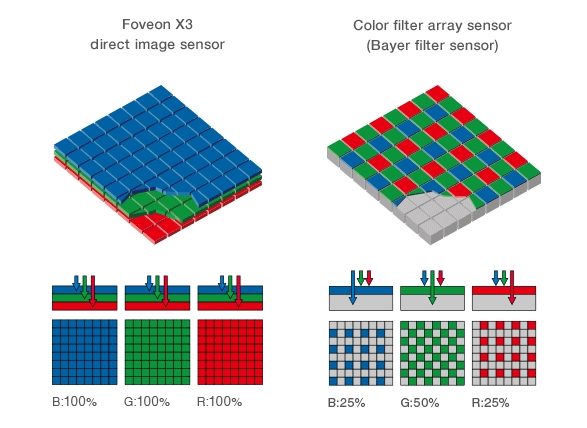
The next figure, below, shows the newest Foveon sensor, which still has the same vertical arrangement, but there are four times as many blue pixels as green and red. The image sharpness is determined by the blue layer. The actual number of pixels is about 39 megapixels, but the equivalent in sharpness are approximately 51 megapixels in total. The green and red layers are the same dimension as the blue, but since the pixels are larger, the sensitivity is increased. The APS-H sensor is larger (26.7 mm x 17.9 mm) than the more typical APS-C (23.5 mm x 15.6 mm). This larger size also improves sensitivity.
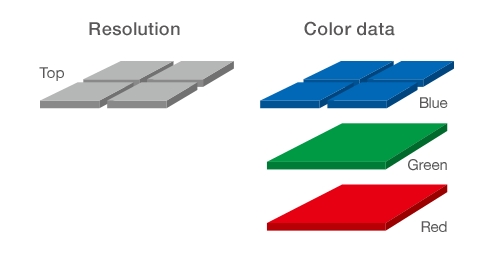
The Sigma SD Quattro H camera is larger than most mirrorless cameras. The on/off switch is at the top of the lens mounting socket, shown below. The shutter release is at the front left in the photo, and around it is a dial for adjusting the f/stop when the camera is in Mode A (Aperture Priority), the shutter when it is in Mode S (Shutter Priority), and both values when it is in Program Mode (Mode P) and Manual Mode (Mode M). Midway to the rear from that point is a Lock switch which locks the camera settings so that you don’t accidentally change something with your fingers when holding the camera. At the rear is another dial for adjusting the exposure above or below the measured setting. Just behind the shutter release is a button marked “QS” which shows the camera settings so you can check everything before taking a photograph and make quick adjustments.
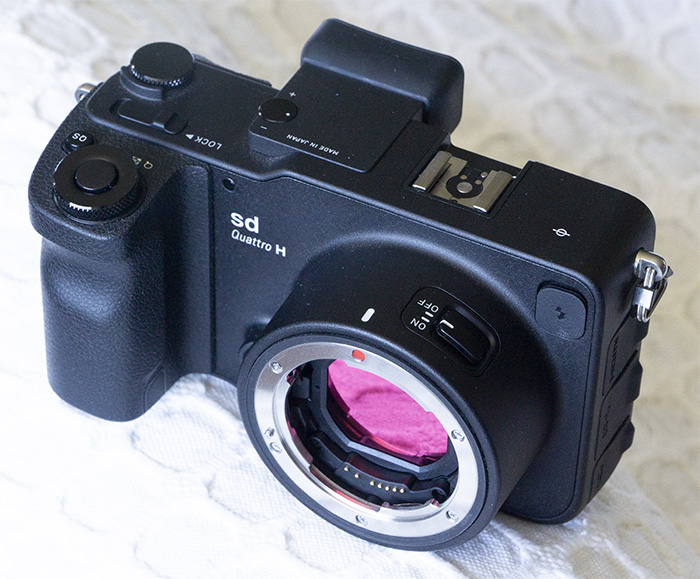
The lens has a switch for Auto Focus or Manual Focus, indicated by the red arrow in the figure below. There are several connectors on the side, including USB 3.0 and HDMI. The USB connector is used for transferring images to your computer, and the HDMI connector is used for viewing images on an HDTV.
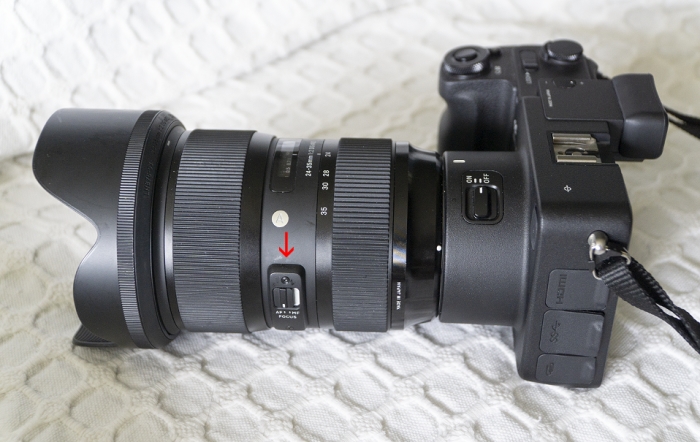
The rear of the camera is shown in the figure below. From here, you can adjust the exposure above and below the measured setting, the ISO, metering (Spot or Center-Weighted), and the Mode (Program, Aperture-Priority, Shutter-Priority). Auto-Focus and Auto Exposure Lock are also accessed, as well as buttons for viewing the photos you have taken and deleting those you don’t want to keep. The button at the top left allows you to place a grid on the viewing screen as well as a horizontal indicator for flattening the horizon. The eye-level viewfinder has a dial to adjust the diopter if you wear glasses.
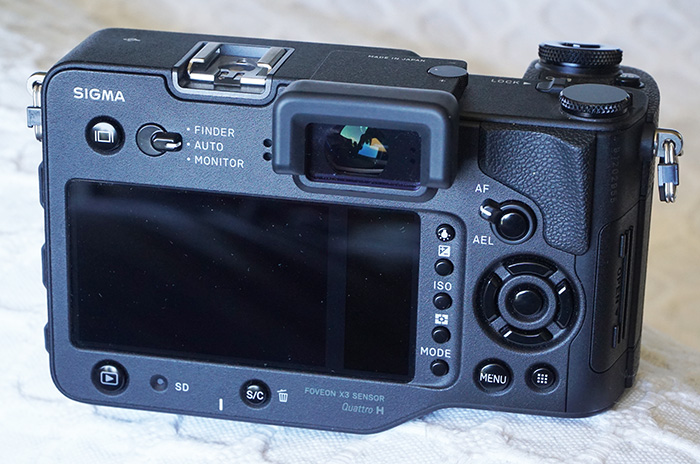
This camera has a lot of features, as can be seen in the specification section above. These include auto facial recognition, bracketing for HDR (High Dynamic Range), Program Mode (exposure and f/stop individually controlled), Aperture Priority, Shutter Priority, RAW image files, Self Timer, Adjustable Aspect Ratio, Dial Exposure Compensation, Focus Peaking, and others.
Focus Peaking is very useful in that it shows the portions of what you see in the viewfinder that are in focus. So, if the area of interest is not shown to be in focus, through the focus peaking indicator, you can adjust the main region of focus so that it is.
There is an SFD Mode which is similar to bracketing. The difference is that, with the SFD Mode, you get the combined image with everything adjusted in the camera. With bracketing, you get the individual photographs that you need to combine in your own software program, such as Photoshop or Photomatix Pro.
The LCD panel on the rear is 3” diagonal in size and does not tilt (it is non-articulated). It has 1,620,000 pixels, while the eye-level viewfinder has 2,360,000 pixels.
Using Sigma Capture Pro, you can operate the camera from your computer. I think this would be extremely useful for portrait photographers.
In Use
I took the Sigma SD Quattro H camera with me when I was out and about. I set it to an ISO of 100 or 200 for all photos except where indicated.
There are two Sigma photo software applications available for download. One is a stand-alone application which can read and adjust RAW image files. The other is a Photoshop plug-in which will allow you to use Photoshop features when adjusting the images from the Sigma camera (including RAW files).
One destination that is very useful when testing a camera is an outdoor vegetable market. Lots of color!
The first figure is the bell pepper display. It had peppers of many varieties. As you can see below, the Sigma camera reproduced them beautifully.
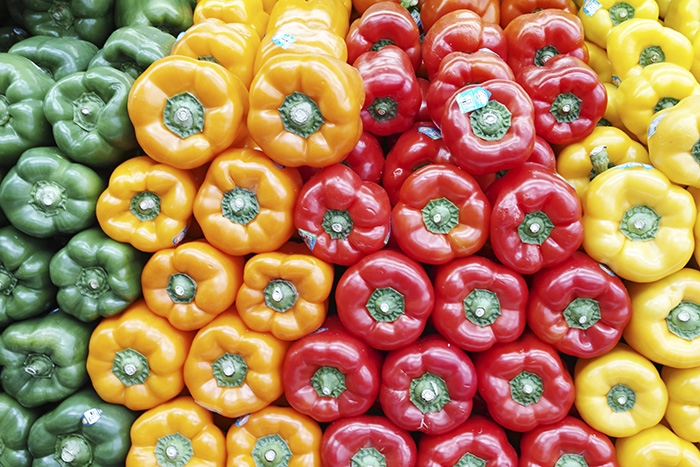
Apples and oranges are good subjects, and the Sigma did well. The colors are very natural. The delicate reds, greens, and yellows in the apples are appetizing.
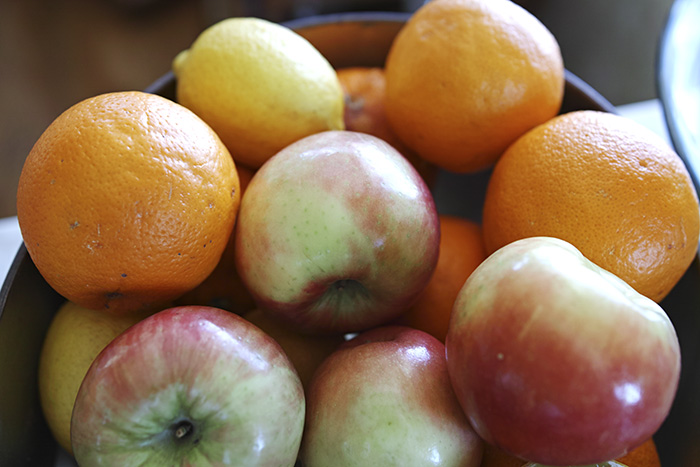
Since the red layer of the sensor is the deepest, I wanted to be sure to check the red capability. Here are some strawberries. There were no problems.

Other fruit was also rendered with great accuracy.
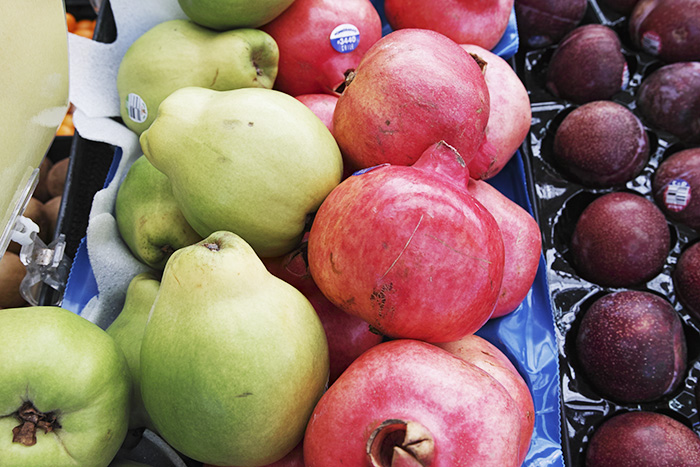
If you have a sweet tooth, as I do, you will appreciate this close-up of some imported hard candy.
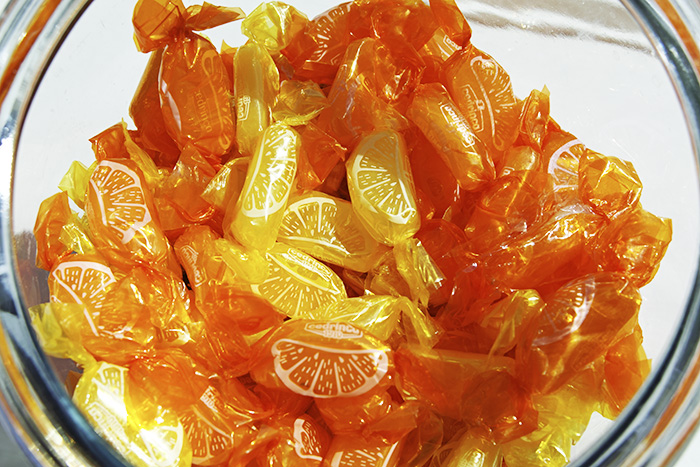
Flowers are an exceptional subject. Here are some with various colors.
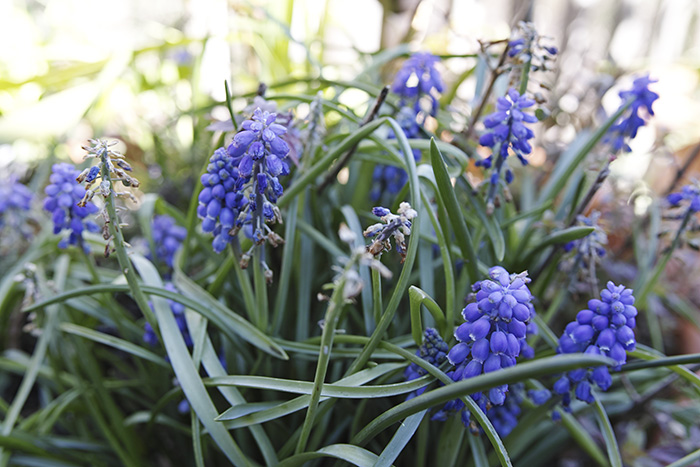
There is good dynamic range here (photo above), with sunlit areas in the rear and shadow detail in the foreground.
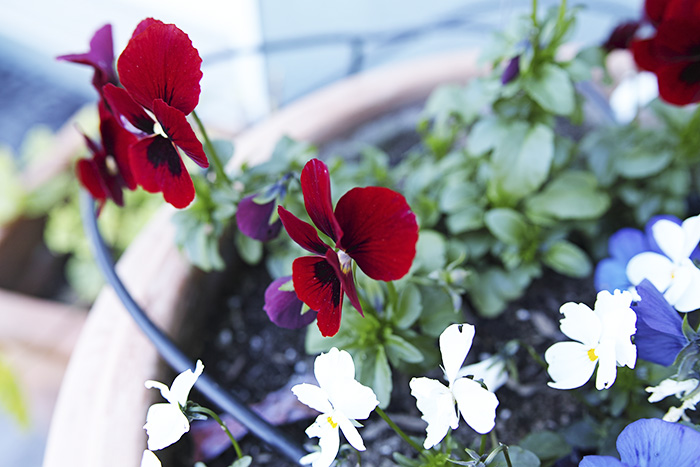
Being in the shade, whites that only take up a small part of the subject matter sometimes tend to get a bit over-exposed (photo above). This is illustrated by the following two plots. The first one is a 3D display of the colors. You can see that the whites are at the top of the display.

The second plot, below, shows that the whites are over-exposed (the peak at 255 to the right-hand side of the plot). All cameras have this problem.
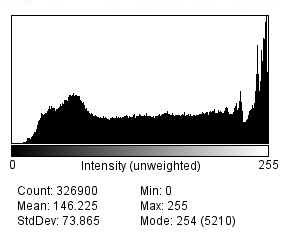
This succulent is rich in greens and reds and is rendered beautifully.
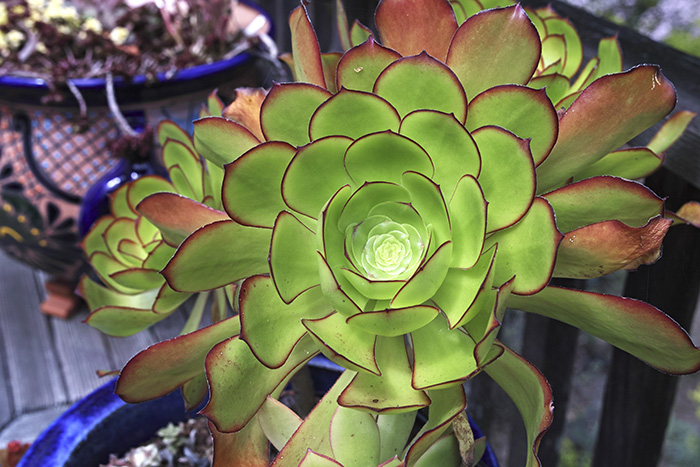
Other vegetables, such as carrots, are photographed with great richness.

A 3D plot of the colors from the carrots is shown below. The whites are close to clipping but are not clipped.
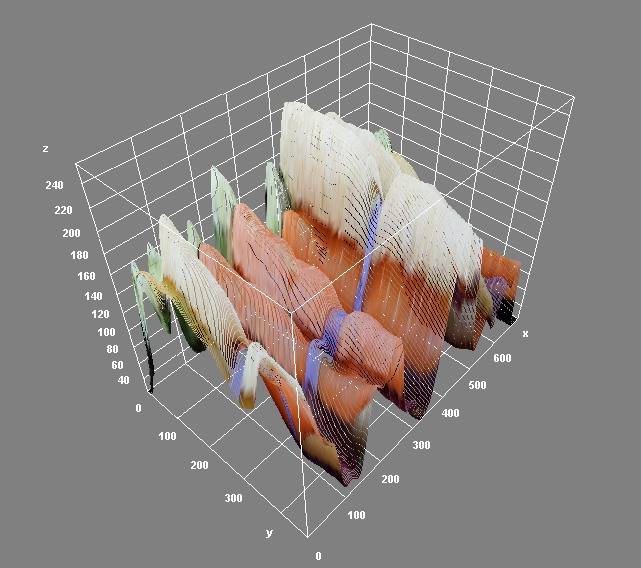
The plot shows the whites are not clipped. Close, but not clipped.
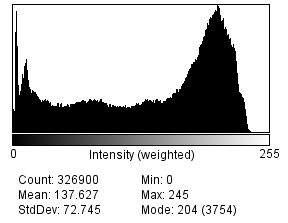
It’s all a matter of how you set the exposure. The exposure meter adjusts itself so that the middle grays are proper. But, since the subject can have extremely dark or bright areas, you must take this into account when considering boosting or reducing the exposure from the measured value.
Here is a photo with many colors, and all of them are rendered with finesse.
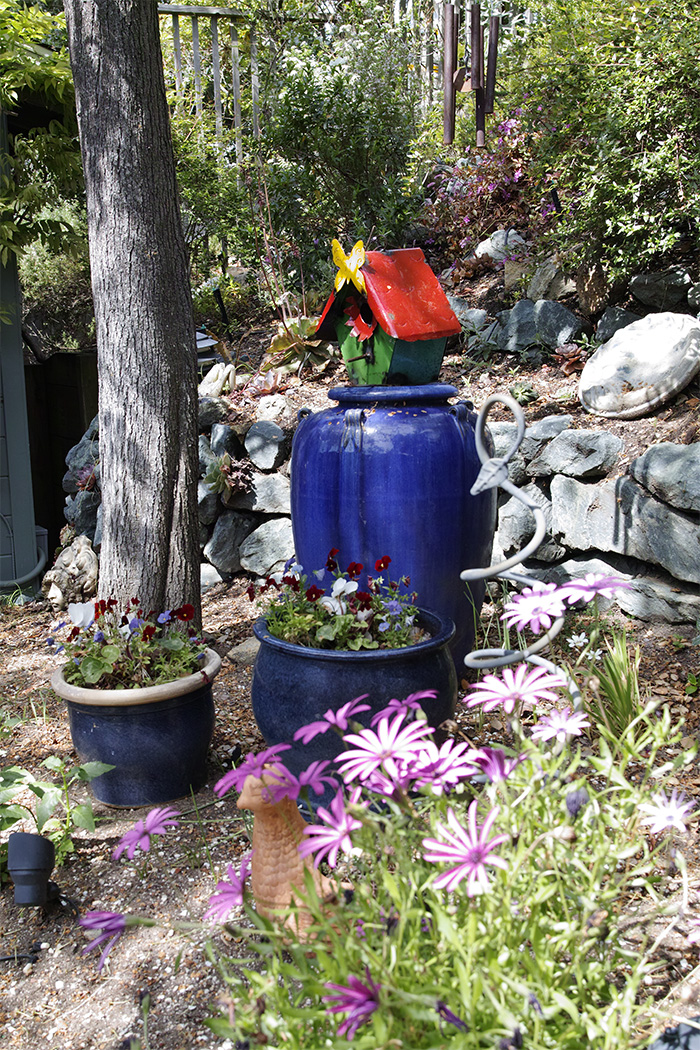
On the Bench
In terms of resolution, the Sigma SD Quattro H camera resolved 4,085 LW/PH (MTF50) out of 5,840 horizontal pixel lines, so it is very good. The Foveon sensor in the Sigma camera is reported to be equivalent to a 51 megapixel Bayer sensor, with the resulting image using the highest resolution setting being 8,768 × 5,840 pixels (a total of 51,201,520 pixels at 3:2 aspect ratio). The actual number of pixels on the Foveon sensor is approximately 39 million.
Here is a resolution and color-check chart, photographed at ISO 100 and f/8 lens aperture. The colors are reproduced accurately.

A close-up (200% blow-up) of the center circle is shown below. The lines are clearly delineated as they converge in the center.
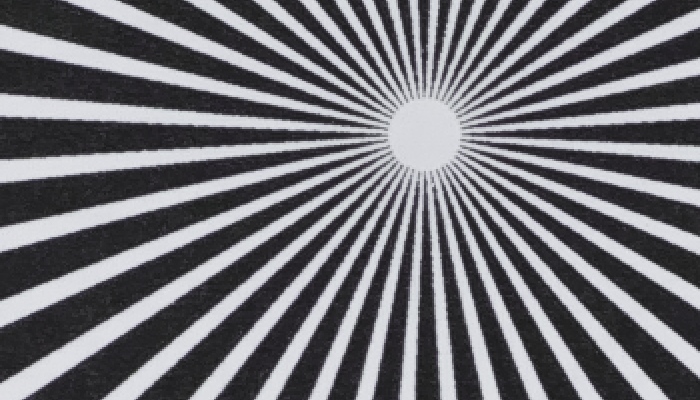
Over on the left-hand side of the resolution chart is a vertical column of the letter “E” in various sizes. A 200% blow-up of the smallest letters (photo below) shows that the camera/lens combination can resolve the 3-point size but not the 2-point or 1-point.
I think new resolution charts are in order. Current cameras out-resolve most of the current charts’ content.
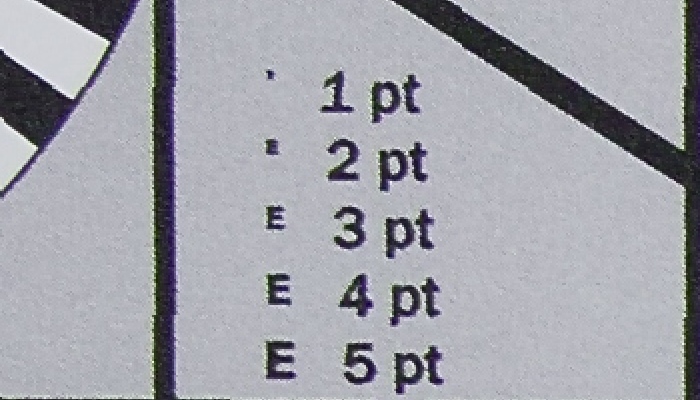
I used a 24 patch color test chart to measure the color reproduction accuracy. When setting up the test, measurement squares are centered on the patches, as shown below. In this particular test, an ISO of 100 at f/8 was used.

Here are the results (the reference is in the upper left, and the input from the camera is in the lower right):
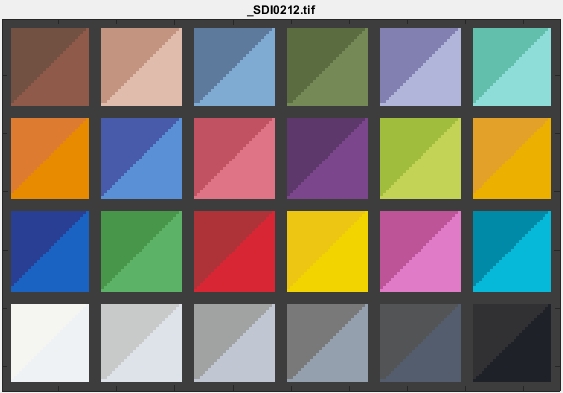
The camera reproduced the colors a bit too bright. This can be adjusted in Photoshop or other photographic software.
A comparison of the color chart taken at ISO 100 and ISO 2000 is seen below. The colors are muted at high ISO, and this is a common procedure for image processing in a camera to reduce noise.
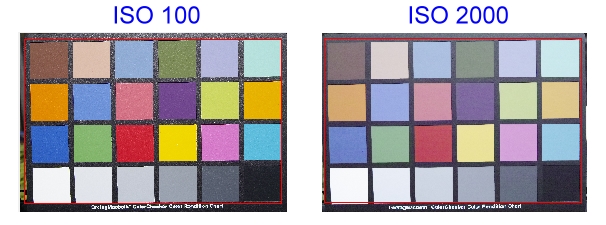
Using the Kodak Q-60 Color target, we can see that the skin tone is very natural. All of the gray levels at the bottom are distinguishable, indicating good dynamic range. This is further illustrated by the appearance of colors in A-1-8 (darkest portion of the image) along with A-13-19 (brightest portion of the image). The various shades of color are distinguishable. This is excellent performance.
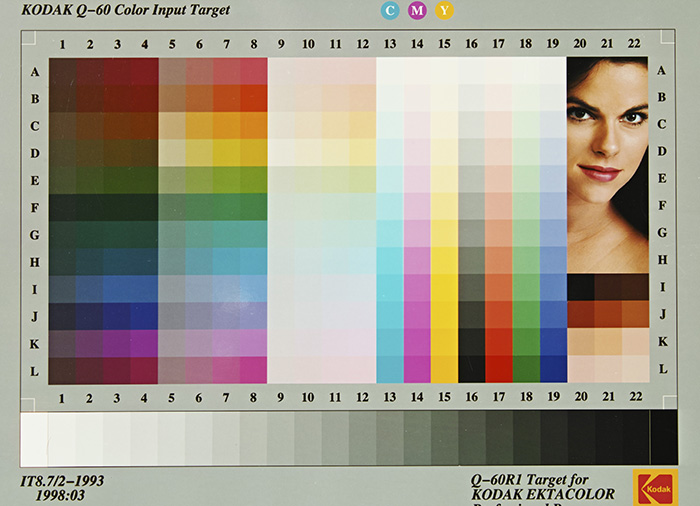
I created a test pattern, shown below, that has fine lines in the primary as well as secondary colors.
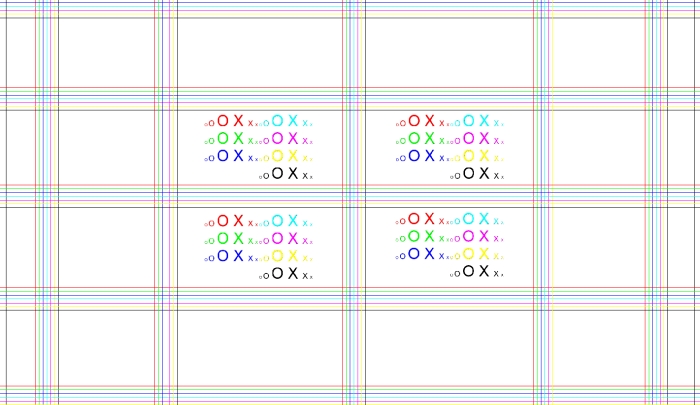
I photographed this test pattern directly on my computer monitor, at ISO 200, f/8, 1/20th second (on a tripod). A 300% enlargement is shown below. All of the colors are clearly illustrated. The vertical lines are 2 pixels wide and appear sharp, considering the small size of the lines. Each pixel on the computer monitor is 0.1 mm wide, so this represents excellent resolution in the photograph, testimony to the very fine lens.
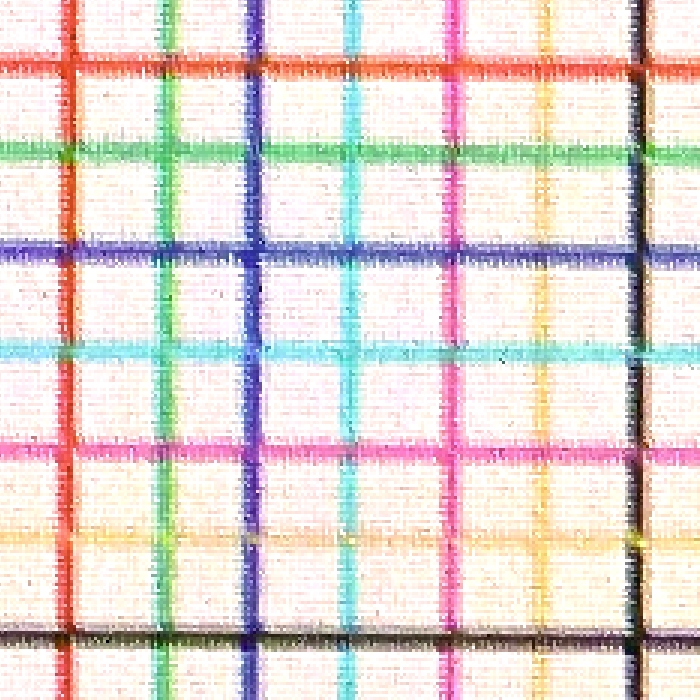
If we plot the noise at two extreme ISO’s, the results are shown below. The first set of graphs are for ISO 100. The second set is for ISO 2000. You can see that the noise level goes up, even in spite of reducing the color saturation. This is a good reason to set the camera to record both JPG and RAW image files. That way, you can adjust the color saturation in the RAW file before saving it to JPG, and you will eliminate the additional lossy JPG compression that you would otherwise have if you adjusted the saturation in the JPG image before re-saving it as JPG.
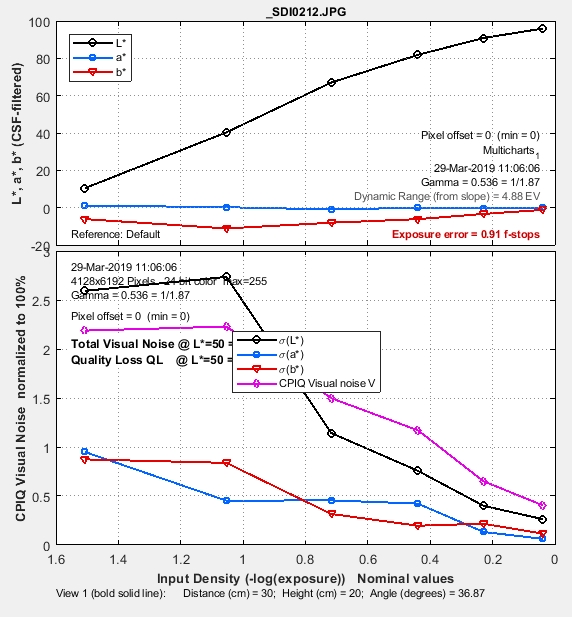
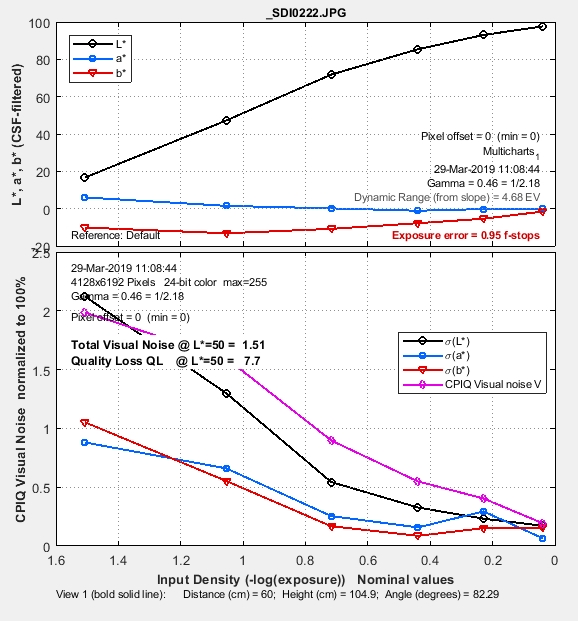
Sensor uniformity is shown in the figure below. I removed the lens and faced the camera towards a southern sky. You can see that the sensor has very good uniformity, with far less than 1 f/stop of variation throughout.
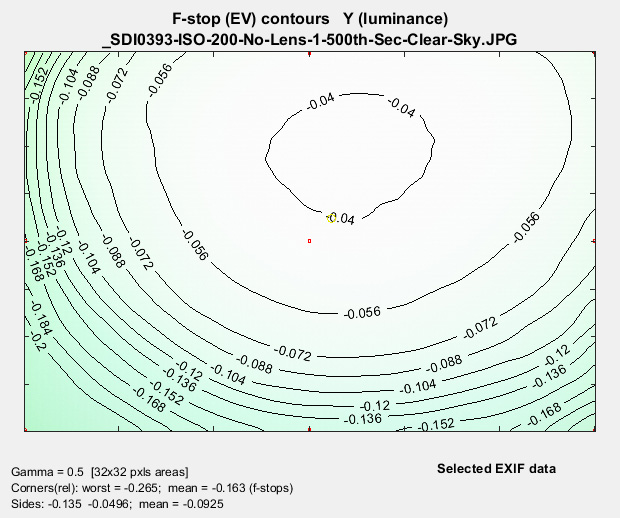
With the lens, there is similarity between 24 mm and 35 mm, shown in the two figures below. The variation is less than 0.1 f/stop.
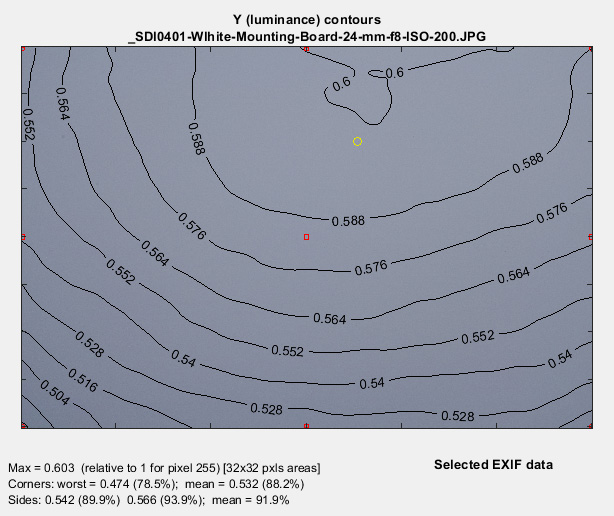
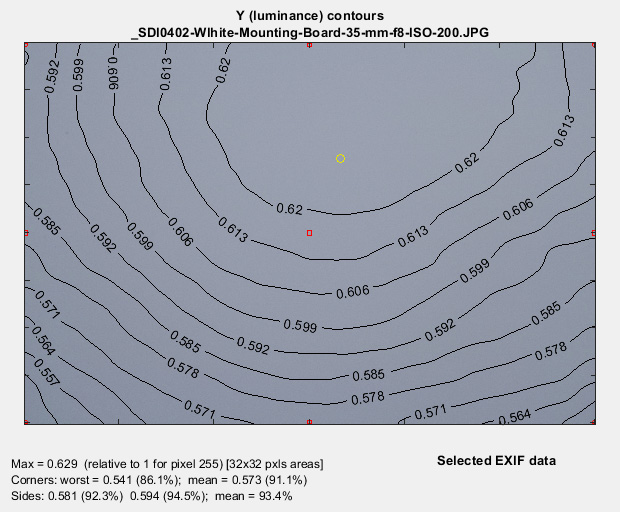
Step Chart analysis shows that the camera has contrast at ISO 2000 (graph 2 below) almost as good as it does at ISO 100 (graph 1 below).
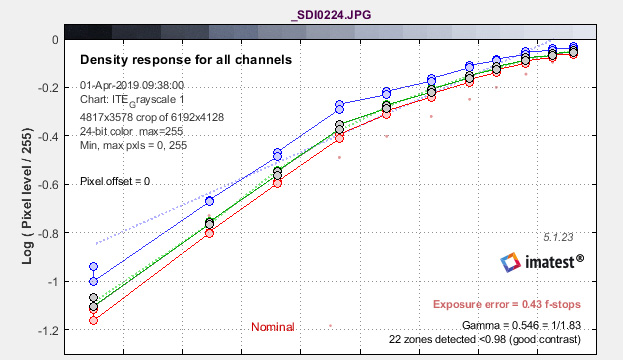
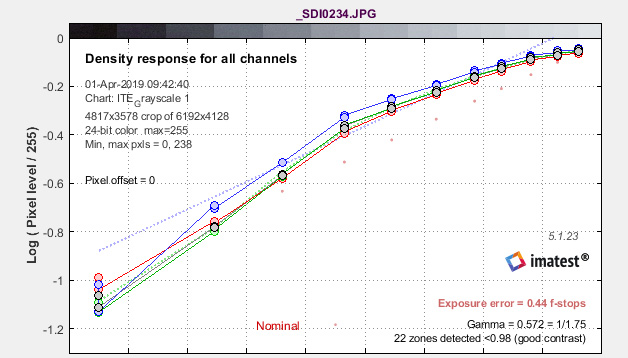
Conclusions
The Sigma SD Quattro H camera and 24-35 mm f/2.0 lens is a great package. Within its best ISO range, it has truly excellent color – very crisp and vibrant. If I were a portrait or landscape photographer, this kit would be in my equipment. While it does have issues at high ISO, it performs extremely well at ISO 100-200, which is fine for controlled lighting portraits and outdoor landscapes. I would suggest using the mode that gives you a JPG and RAW image file for each photograph. Above ISO 500, color saturation is noticeably muted. You can increase the saturation in Photoshop or other photo software, but that will also increase the noise.
This particular lens is superb. One of the best I have ever used. It is available with lens mounts for Canon, Nikon, Sony, and Sigma cameras.
The next step for Sigma is to take the Foveon sensor to a full frame size (24 mm x 36 mm). At that size, there could be 24 megapixels each for all three primary colors, Red, Green, and Blue. Color performance would probably be significantly improved at higher ISO’s.
I would also like to see 4K video capability. That is a standard feature now on photographic (as compared to video) cameras.
Lastly, it would be nice to have the LCD monitor be articulated so it could be tilted to be viewed from above when holding the camera at waist-level.
